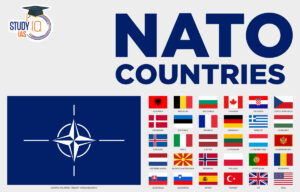Table of Contents
Kyoto Protocol
The Kyoto Protocol was formally adopted on December 11th, 1997, but it wasn’t until after a protracted ratification procedure that it went into force on February 16th, 2005. As of right present, there are 192 Parties to the Kyoto Protocol. The UNFCCC’s third Conference of Parties (COP3) session, which took place in 1997 in Kyoto, Japan, and saw the passage of the Kyoto Protocol, is referred to as COP3.
Reducing carbon dioxide emissions and the amount of Greenhouse Gases (GHG) in the atmosphere is the goal of the Kyoto Protocol. The fundamental tenet of this accord was that industrialized countries should reduce their emissions. It is a crucial component of the UPSC Syllabus for environment and ecology. All candidates must have a thorough understanding of the Kyoto Protocol’s history, guiding principles, operating procedures, and other elements.
Kyoto Protocol 1997
The United Nations Framework Convention on Climate Change (UNFCCC) is implemented thanks to the Kyoto Protocol, a global agreement. The UNFCCC, a multilateral environmental convention that became effective on March 21, 1994 at the Earth Summit, is the first set of international laws intended to carry out its provisions of combating climate change. Its purpose is to combat global warming by bringing atmospheric greenhouse gas concentrations down to a level that would stop dangerous human climate change.
The Kyoto Protocol adheres to the Convention’s annex-based structure and is based on its rules and provisions. Because it acknowledges that industrialized nations are mostly to blame for the current high levels of GHG emissions in the atmosphere, it merely binds them and lays a greater weight on them in accordance with the principle of common but differentiated responsibility and respective capabilities.
The UNFCCC’s goal of preventing global warming by lowering greenhouse gas concentrations was carried out under the Kyoto Protocol. There are currently 192 parties engaged.
Read Also: List of Environment Conventions and Protocols
Kyoto Protocol History
The Kyoto Protocol was established at the third UNFCCC country (United Nations Framework Convention on Climate Change) conference, which took place in Japan in 1997. It was approved on December 11th, 1997. It became effective on February 16th, 2005, when Russia ratified it. Kyoto is the name of the Japanese city where the protocol was negotiated, but it is also frequently used to refer to the agreement itself in conversations on climate change.
Principles of the Kyoto Protocol
The concept of “Common But Differentiated Responsibilities (CBDR)” is the foundation of the Kyoto Protocol. It holds industrialized nations accountable for lowering existing emissions because they previously contributed to the atmosphere’s present concentration of greenhouse gases. The responsibilities for different countries have been take in two ways as per Kyoto Protocol, According to CBDR,
- Historical Polluter
- Resent Polluters
| Principles of the Kyoto Protocol | |
| Historical Polluter – Developed Countries | Resent Polluters – Developing Countries |
|
|
Target and Responsibility of Kyoto protocol
The Kyoto Protocol is intended to help nations cope with the negative effects of climate change. It makes it easier to create and use strategies that can help people be more resilient to the effects of climate change. The Kyoto Protocol’s requirement that the European Union and 37 industrialized nations reduce their greenhouse gas (GHG) emissions is one of its key aspects.
On the grounds that the developed nations who caused the issue should be the ones to take the initiative to solve it, the convention does not establish reduction goals for poor nations. However, in the future, rapidly growing economies like those of China and India will have a significant impact on GHG emissions.
| Targeted Gases under the Kyoto Protocol | |
|
|
Member Countries of Kyoto Protocol
The agreement, which has been approved by 184 countries, and its wide support provide the fight against climate change enormous worldwide momentum.
| Member Countries of Kyoto Protocol | |
| Particulars | Details |
| Annexe I | Includes countries as
|
| Annexe II |
|
| Annexe B |
|
| Non-Annexe I |
|
| Least Developed Countries | No binding targets to reduce GHG emissions. |
Mechanisms Kyoto Protocol
The Kyoto Protocol’s provisions make it easier to switch from using older, dirtier technology to using newer, cleaner systems and infrastructure, which has apparent longer-term advantages and is more cost-effective. Countries that are required to fulfill the Kyoto targets must do so primarily through domestic action, or by cutting their domestic emissions. However, they can partially achieve their goals through three “market-based mechanisms,” sometimes known as the Kyoto mechanisms. The mechanisms of Kyoto Protocol includes the following:
Clean Development Mechanism (CDM)
Developed nations produce more pollution and lose carbon credits. They give poor and least developed nations financial support so that they can generate sustainable energy (solar, wind, etc.) and earn some carbon credits, enabling them to comply with their Kyoto Quota (Kyoto units) emissions obligations without breaking any rules.
Joint implementation (JI)
Through this mechanism, a nation that has agreed to reduce its emissions in accordance with the Kyoto Protocol (an “Annex B Party”) can acquire emission reduction units (ERUs), each of which is equal to one tonne of CO2, from an emission-reduction project in another “Annex B Party” and apply those ERUs toward reaching their Kyoto target. As the host Party gains from foreign investment and knowledge transfer, the joint implementation gives Parties a flexible and economical way to fulfill a portion of their Kyoto commitments.
International Emissions Trading
These emissions can be sold to industrialized nations that create more than is appropriate by nations who emit less than is permitted. Reducing emissions becomes profitable commercially in this way.
Doha Amendment to Kyoto Protocol
The Kyoto Protocol’s Doha Amendment was approved for a second commitment period, beginning in 2013 and extending through 2020, on December 8 in Doha, Qatar. 147 Parties had deposited their acceptance instruments as of October 28, 2020. As a result, the need of 144 documents of acceptance for the Doha Amendment’s entrance into force was met. The modification became effective on December 31, 2020.
A total of 37 developed nations and economies were in transition during the first commitment period, and the European Community pledged to reducing GHG emissions to an average of 5% below 1990 levels. Parties agreed to reduce GHG emissions by at least 18% below 1990 levels over the course of the second commitment period, which runs from 2013 to 2020.
Kyoto Protocol and Paris Agreement
The two such agreements as the Kyoto Protocol and the Paris Agreements although they both were designed to reduce greenhouse gas emissions, their implementation strategies and target audiences were very different. Within the framework of the United Nations Framework Convention on Climate Change (UNFCCC), the Paris Agreement addressed reducing greenhouse gas emissions whereas Kyoto Protocol is a treaty that commits state parties to cut their emissions of greenhouse gases based on scientist consensus. Check the table below to know more on Kyoto Protocol and Paris Agreement:
| Kyoto Protocol and Paris Agreement | |
| Kyoto Protocol | Paris Agreement |
| It was established in 1997 | It was signed in 2016 |
| The Kyoto Protocol primarily targeted industrialised nations as they were considered the primary emitters of greenhouse gases. Developing nations were exempt from the Kyoto Protocol | The Paris Agreement required both developing and developed nations to reduce their greenhouse emissions |
| The objective of the Kyoto Protocol was to reduce greenhouse gases to 5.2%, below pre-1990 levels | The objective of the Paris Agreement was to prevent the average global temperature from rising more than 2 degrees Celsius above pre-industrial levels |
| The Kyoto Protocol was aimed at 6 major greenhouse gases such as carbon dioxide, methane, sulfur hexafluoride, HFCs, PFCs and nitrous oxide | The Paris Agreement was focused on reducing all anthropogenic greenhouse gases |
| The first phase of the Kyoto Protocol lasted until 2012 | The goals of the Paris Agreement are to be achieved between 2025 and 2030 |
Kyoto Protocol UPSC
In order to address global climate change, the Kyoto Protocol was a global agreement created under the United Nations Framework Convention on Climate Change (UNFCCC). Even though it is no longer in force, the Kyoto Protocol is still relevant for the majority of difficult tests. It is a crucial subject in the UPSC Syllabus’ Environment and Ecology portion. The Kyoto Protocol UPSC subtopics that are listed above are occasionally brought up in the UPSC Prelims and Mains tests.


 UPSC CMS Admit Card 2025 Out: Download L...
UPSC CMS Admit Card 2025 Out: Download L...
 UPSC Study Material for Prelims & Ma...
UPSC Study Material for Prelims & Ma...
 NATO Countries List 2025, Members, Funct...
NATO Countries List 2025, Members, Funct...





















